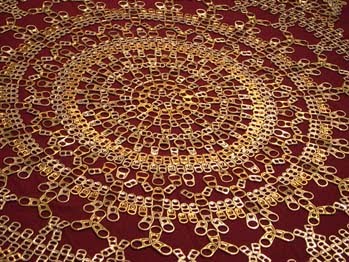In the hall outside my studio there is a wall of paste-up posters, screen-prints I think. They are bold and graphic, include lots of text and mostly, highly political. Many of them promote exhibitions, group shows, some are calendars and others like banners for rallies. "The defeat of labour is not the end - it is only the beginning!" they cry; "Gay Radio Monday 11.30"; "A Pena in Support of El Salvador". Going by the imagery and the phone numbers, these posters are at least 25, maybe 35 years old. Those with dates are around the mid-1980s. Without fail they are engaged, socially committed, didactic and strident. These posters represent people who cared.
When I started at art school in the late 1990's, the posters were already there, but they haven't been added to in the time I have been in and out of this building. To be sure, have been some of my contemporaries who have followed the poster tradition and political ethic, and paste-ups are part of the vernacular again. But the site of most activism has moved and it is less didactic than before. Activism turns on information. Trade unions are no longer where the biggest numbers can be organised, social media is. The left don't rally out the front of parliament as much as truckies and loggers do - albeit in small numbers.
I'm wondering why it is that I see parallels between these paste-ups and the participatory art practices I'm researching now. When we see these kind of imagery and texts in art now, it is tongue in cheek, satirical - and usually, preaching to the converted. A little in-joke for all we enlightened arty folk, at the expense of the supposedly ill-informed masses - the readers of the Telegraph. It has little in common with the upbeat, utopian rallying cries of the organisers in the 80's. Where we see those ideals emerge, is in community artists; those who run ceramics workshops for isolated urban women; Aboriginal dance performances for kids in regional schools; theatre revues performed by adults with down syndrome.
From my reading it seems much of this participatory art practice in the US emerged first in the late 80's and early 90's (Lacy, 1995) and according to some has only a slim relationship with the situationist and performance art of the decades before (Kester, 2004). I speculate that participatory art practices have emerged from decades conservative government. When millions of protestor around the war couldn't stop troops from entering Iraq - twice. When prime-ministers could tell-bald faced lies about refugees and children overboard, with barely a murmur of dissent. In the face of this conservatism proceeding within a democratic system - a hard-hearted capitalism we elected over and over again - what is a bleeding heart lefty to do?
It can be argued that creating socially engaged, participatory art projects when conservative governments neglect social services merely props up that system, instead of challenging it. It must be said that communities shouldn't have to rely on civil society to provide services. We all pay high taxes to a government that should be responsible for providing equal access to rights and representation, health and education, infrastructure and safe environments.
I imagine participatory art as the practice of being the change you want to see in the world. Not only demanding others see and want it, but working at making it real. Creating an alternative space where compassion and service can prove their value - a pilot-project that demonstrates what can be done with little - imagine what could be done with so much more.
We should rally. We should organise. We should shout and carry on, and sign petitions and find out more about the dirty deeds of our elected and unelected representatives. But we should also act, live our beliefs, volunteer, participate, donate. A movement is a multi-dimensional act. We should move in all directions.
